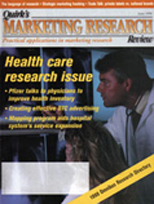How far is too far?
Editor’s note: Anthony C. Stanowski is the former director of planning and market research, Jefferson Health System, Philadelphia. He recently accepted a position with the Sachs Group, a Chicago-based company that specializes in planning and marketing software for the health care industry. Sharon B. Dajnowski is planning analyst, Main Line Health, Philadelphia.
Main Line Health (MLH) is a four-hospital entity of the Jefferson Health System (JHS) located in suburban Philadelphia. Among the full range of services, three of our facilities (Bryn Mawr, Lankenau and Paoli Memorial Hospitals) provide obstetric services. The Paoli site opened in 1995 based upon the growing population and demand for services in the western suburbs.
An earlier article by one of the authors presented a centroid analysis study (GIS World, January 1993) which demonstrated this growth and movement west. Since Lankenau borders the eastern end of the MLH service area, we need to understand whether we should allocate more resources west or continue to offer services at all three campuses. Bryn Mawr is only four miles west of Lankenau.
In order to create efficiencies in providing obstetric care services, MLH is examining the potential to consolidate services in the eastern part of its service area. We wanted to understand if the difference in travel distance and time would be a significant obstacle to obstetrics patients based on the facility they are currently using.
An analysis was developed to measure the mean travel time and distance of patients to each of the three facilities. The mean travel time and distance of each patient to the site at which they received care would be compared to the time and distance to each of the other facilities in our system.
One potential scenario is the consolidation of inpatient obstetric services at Bryn Mawr Hospital. Outpatient services would continue to be provided at current locations. We wanted to understand the hypothetical impact on Lankenau Hospital patents if they were to receive their inpatient services at the Bryn Mawr Hospital. Increasing travel times significantly would reflect poorer access to patients, and would not be in keeping with MLH’s mission.
The difference in mean travel time and distance of primary importance is that of Lankenau patients going to Bryn Mawr Hospital. We examined Bryn Mawr patients going to Lankenau Hospital, and travel times to Paoli for comparative purposes.
Geocoding patients
We created a database of patients (including their full address) admitted to one of the MLH facilities’ obstetric service for the period of one year. Each address was geocoded to the address level, where possible, and then to the ZIP code level. We were successful in geocoding 70 percent of the addresses to the address level. Thirty percent were geocoded to the population centroid of the ZIP code of residence.
Assignment of travel distances
The calculation of the travel distance was performed by using Atlas GIS, a mapping program of ESRI, Inc., Redland, Calif. The distance from each geocoded item to each MLH site was calculated using the straight line method. To prevent skewing of the data due to outliers, addresses that were 50 miles or greater from the site of service were excluded. These patients are only 0.8 percent of the entire patient population being examined. The mean travel time to each site based on the site of service was determined by calculating the mean travel distance by site of service to each facility.
Assignment of travel times
The calculation of the travel time was performed using ArcView Network Analyst, also by ESRI. The travel time is calculated using an algorithm based on the travel distance along a segment of road times the estimated speed limit for that segment of road. Although this method does not account for traffic variances and road construction, it is felt to be a good approximation to estimating travel time.
Two-minute travel time rings were built around all three sites (reference Map 1). We assigned the travel time of each patient to each facility based on the proximity of patients. If patients were within 22 minutes of our facilities, we assigned the mean travel time in the ring ((High Time/Low Time)/2). For example, if an obstetric patient lived in the 2 to 4 minute ring around a site, her travel time would be 3 minutes ((4+2)/2).
Travel times over 22 minutes were assigned based on Table 1.
The result
Table 2 shows the results of the analysis. It was determined that the mean travel for patients who received care at Lankenau to go to Bryn Mawr was actually closer (by 0.1 mile) but represent a slightly longer travel time (0.5 minute longer). Closing the Lankenau site to inpatient OB would furthermore be less disruptive on our patients than other alternatives.
This data is being used as additional information in determining consolidation/clinical integration is being gathered. Consumer preference information, physical plant layout, physician acceptance of change, and community concerns will need to be addressed before future consolidation can be accomplished.
